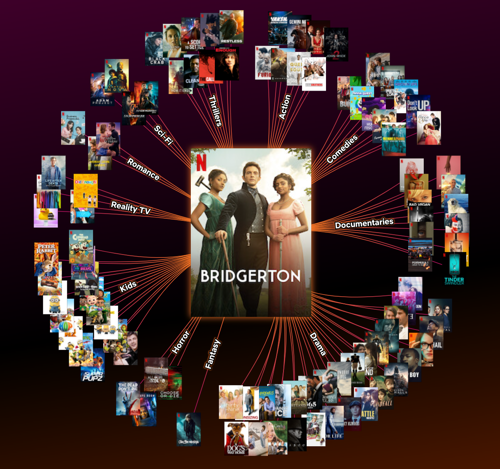Mediocrity: The problem with algorithms
When was the last time you were surprised by a piece of content served to you?
For me, those moments are few and far between. Perhaps, if I’m honest, the closest I’ve come in the past few months is the “Lucky Links” section at the end of emails from Paynter Jackets. They offer a good curation of random bits of interesting content. Pretty niche, and nothing to do with algorithms - I did sign up to the brand's newsletter. But a lovely case of being presented with something fascinating that I never knew I was interested in until I consumed it.
I’ve been thinking more and more about content that cuts through the noise. Content designed to compete in the attention economy, making people take notice and feel something. Content designed to generate a positive perception. Content designed to encourage action or behaviours. And, the more I think about and discuss the topic, the more I think that we - with “we” being the industry community involved in the creation of content and experiences - are not regularly pushing the boundaries of what could be amazing and impactful. As a result, we (as consumers) are left with experiences which are, I feel, distinctly average for the most part.
Of course, there are exceptions. But a conscious review of my various social feeds, email comms, Netflix, Spotify, Disney +, Rightmove, shopping, and news-type websites led me to think that algorithms, and our industry’s dependence on them, has had a dulling effect on mass-market content and experience. In my experience, most ads are formulaic. Shopping experiences are homogenous. Personalised experiences fall short. And recommendation engines are ok but rarely awesome. And it appears I’m not alone. In Future Commerce’s Visions 22 report, it cites one key theme in relation to eCommerce as being the homogenisation of experiences. People feel bored and fatigued by the sameness.

With all of the data available and technical advancement, together with the brilliant minds and talented creative people, why do things feel predominantly safe? I wanted to explore what might be happening.
Evolutionary rather than revolutionary
Algorithms across music, film, tv and those involved in the creation of fashion, are created by those with financial incentives based on satisfaction. “Everything is popular, but nothing is the thing you didn’t know you wanted,” observed Ross Douthat in a fantastic recent New York Times piece. Rather than help consumers discover new artists, genres, shows or styles, algorithms fall back to the familiar, the safe, the tried and tested formula.
The effect of algorithms means that across the fields of mainstream entertainment, content is being narrowed based on what type of content has performed well previously and what the user is familiar with. It seems to be survival of the fittest in terms of what will keep people subscribed and investors happy with performance.
While £250 million was spent in the UK on A&R investment (nurturing and marketing artists and their music) in 2019 according to the British Phonographic Industry body, significant investments in the music industry are being made for royalties and artists’ back catalogues. Two such investments include Universal Music Group paying $300 million for Bob Dylon’s back catalogue while music investment company Hipgnosis Songs Fund Ltd spent £500 million pounds last year for the rights to songs, with the fund returning 17% in the past 12 months as reported on Bloomberg.com. We all love music that whips up nostalgia, and love a soundtrack that helps us escape, but it seems that algorithms are failing consumers in discovering new and emerging artists on these mainstream platforms when it should be technically doable. And for a brand like Spotify that uses its customer data so effectively for marketing campaigns – demonstrating a true understanding of human behaviours and a commitment to surprise and delight – it’s a shame the algorithms don’t match that level of thrill for the most part.
Similarly in TV and film, a tried-and-tested approach has been winning. Netflix’s investor relations states that, “Since 2013, we've been at a scale where we can economically create original content for Netflix and our offering has improved as we grow further and gain greater confidence. With each original, we learn more about what our members want, about how to produce and promote effectively, and about the positive impact of originals on our brand.” So, for nearly a decade, the entertainment giant has been perfecting its formula of creating content that its members have indicated they want. Not what they might not know they want…yet.
Ted Sarandos – Netflix’s co-CEO - talked about the success of the brand at this year’s Cannes festival: “The key to our success is ensuring that there’s always something for everyone to watch on our service. But “something for everyone” doesn’t mean “everything is for everyone””. I understand the sentiment but it’s not particularly inspiring. Of course, it’s not a bad thing that industry giants are focused on giving people what they know they want. But as Douthat explores further in his article looking at various industries, it does mean that investment is being directed away from exploring something more risky, but potentially much more exciting.

It's become 'Business first. Consumer second.'
For entertainment brands, it seems that perhaps the business objectives have overshadowed the human motivation for engaging with these brands in the first place. Take Netflix: Fundamentally, people want to be entertained but don’t want to waste time deciding what to watch. Netflix, while wanting to satisfy users, also wants to continue to secure investment / retain investors by keeping subscriber numbers at a certain level. And Spotify: People want to discover good music and audio content. Spotify, while wanting to serve users, wants to keep users and advertisers satisfied by helping people find content they like.
This apparent shift from human perspective to business perspective has resulted in algorithms designed to deliver safe recommendations and creative budget being directed toward tried and tested content.
The fashion industry has gone the same way, moving from creative strategy among talented minds to what seems like daily tactical activation of same-ness if I consider the constant flurry of “latest drop” “just in” notifications. Largely due to algorithms predicting trends which can be acted upon and collections churned out in the time it takes for me to click from my ASOS discount email into the app.
Surely the technical advancement in algorithms could work to share something surprising rather than something safe? Rather than something that I have already indicated I like through consumption, could they perhaps experiment with the nuances of my personal taste? Yes, there’s a risk involved but there’s also the potential to recommend something amazing. That’s the kind of advancement I want rather than algorithms being used to provide me with content I have already asked for. Why does mediocrity of experience feel cultural across industries involved?
The safety of measurement outweighing the potential of the unknown.
Risk. It’s something we’ve become uncomfortable with as an industry. We’ve come to be able to measure performance so well, that that is what we focus on. We focus on what can be proved before we explore what might be done creatively. As measurement becomes more sophisticated and adtech companies bang their drums, whipping us all up in a frenzy, it becomes very difficult to pursue or experiment with ideas that might be more difficult to prove as effective in the short term. There will always now be about 100 ways (perhaps an exaggeration) budgets can be invested in efforts that can be measured, deliver positive results, and be slotted into board reports – in agency, technology company and brand - the following quarter. It’s become more important to play it safe than risk upsetting the balance sheet.
It takes a brave client (and a good trusting relationship with an agency partner) to break the mould. In the current state of play, what we see is a trend of courage not being encouraged. Budgets are unlocked and campaigns are created based on what has worked before and what we can prove has worked in a relatively short space of time. The problem with that is that we’re more likely to underinvest in areas which could prove more valuable in the long term, but more difficult to prove in the short term. And over invest in the bottom of the funnel work activity which we can prove very easily. An uncomfortable feeling I’ve been guided on recently as part of Rory Sutherland’s fantastic MAD//Masters course, and something that has impacted the creativity of brand and performance marketing.
Mediocrity made for an easy life
For several years, the digital marketing industry has fixated on leveraging targeting capabilities of platforms. Of course, that’s not a bad plan. We should be exploiting what’s available to us to maximise the impact of our efforts. However, the platform algorithms if harnessed expertly, were able to do the heavy lifting in terms of generating results, and that led to pretty safe creative being the default. Quite simply, as long as campaign activation was run by effective specialists, the creative didn’t need to work particularly hard to achieve the things we set out to do. The creative and messages were being delivered to those people at the bottom of the funnel, ready to engage.
Similarly, marketers have responded to algorithmic changes, evolving their strategies and switching tactics accordingly to play the game. Look at the tiktokification of social media as Mark Ritson talked about recently, and before that, the flurry of brands with content and aesthetic that were “made for the ‘gram”. Lots has been written about blanding. What this means is, as consumers, we’ve been served wave after wave of content designed to play the algorithms. It’s as if the algorithms are writing the creative briefs.
As humans, we naturally tend to take the easiest routes to get solid results. And that’s what marketers have been doing for the most part. It avoids uncomfortable client conversations, gets the results we need, audiences are relatively happy. Win win win. In this case, mediocrity was passable and unchallenged because the algorithms were that good and content was ‘trendy’.
There’s hope on the horizon
So, in light of a sea of homogeny and challenge, what can we be sure of? We can be sure that some things will continue to change. And some things will remain the same. How wonderfully ambiguous.
Algorithms will advance. Technology will progress. Platforms will move to make it more challenging for brands. My colleagues Gordon and Gillian are the experts here so check out their pieces on the latest developments in the landscape.
More people will push the boundaries of content creation in their own communities and on multiple platforms. And consumers will change their behaviours to satisfy their needs. We can see this with the growth of TikTok, Medium, Substack and reddit as people seek to delve deeper into their interests, create their own content, and engage with likeminded communities on alternative platforms. On the flipside, people will always crave emotional stimulus. We will always want to be entertained. Stories will continue to be a critical way we form connections. And emotional response will always drive decision-making and purchase decisions. We are humans after all.
I’m optimistic for the future. There are certainly flurries of hope – Netflix's growth has been challenged. Spotify is making a strategic move toward a more “playful” experience. And of course, there are some brilliant bits of content being created. However, the need to experiment more is clear. We’ve entered a digital landscape where past performance is increasingly not indicative of future performance. The algorithms are doing their job, but no one is truly satisfied.
Our industry must take a step back and reconnect with the ambition of creating content that will make people feel more than just, “nice”.
What can we do to explore ideas for more creative content?
- Ask better questions of the brief and unpick the problem at hand. The slow elevator example is thought-provoking.
- Explore potential by reframing what we’re trying to achieve from the human perspective rather than the business perspective. Align with business objectives, but don’t get lost in them. Check out Mark Pollard for great advice.
- Look at the data – both quantitative and qualitative if possible - to try to understand our audiences, and their contexts, as much as possible.
- Leverage our knowledge of algorithms but don’t be beholden to them, or treat them as a prescription for creative
- Experiment more. More than you feel comfortable with probably.
- Seek to create value over securing validation.
We work across campaign, brand, digital experience and ecommerce so I get first-hand experience of the difference it can make when clients buy in to the potential value of the content experience in specific contexts. As we move towards a cookie-less future and algorithms continue to largely underwhelm, we’re on track to continue to challenge ourselves to make the best content experiences we can. And as consumers, we’re in for some experiences that might actually surprise and delight us.
Let’s move away from evolution toward extinction. Mediocrity may be cultural, and it will be hard to challenge. But we should. As an industry, we should aspire to be a bit more revolutionary in consumers’ mind when it comes to content. The algorithms aren’t working for consumers, so we must roll up our sleeves and try something innovative.
Do get in touch if you have any questions or comments, or Netflix recommendations.
Written by: Helen Davidson
Read more of our insights

Brand Awareness: Defining, Measuring, and implementing it into your marketing strategy
"Brand Awareness" seems quite self-explanatory. Is it only about people hearing about your brand? Our Marketing Manager, Gordon McCaw shares all the knowledge you need to create a successful brand awareness strategy.
Read more

Supercharging strategy: The role of audiences
Taking an audience-insight led approach to marketing and media strategy will deliver huge benefits.
Read more

Challenges and Opportunities of Advertising on Radio and Streaming Services
With 87% of the population tuning into the radio every week, along with the adoption of smart speakers in the home, it’s no surprise that radio is a huge consideration within any of our media plans.
Read more
